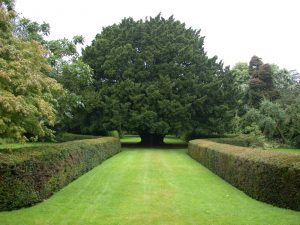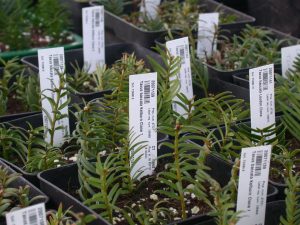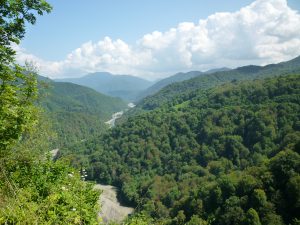Work is soon to start with the removal of the existing perimeter hedge at RBG Edinburth Inverleith site and replacing it with plants of the Common Yew (Taxus baccata). The replacement conservation hedge will include plants collected from threatened wild populations and famous heritage trees. Planting will start in April 2014 and continue over a number of years to create an important conservation resource.
The Common Yew has played a fascinating part in the culture of mankind through religion, folklore, medicine and warfare. Today nearly every churchyard is graced with yew trees which represent a powerful symbol of resurrection. The yews are famed for being extremely long-lived with some reputed to exceed several thousands of years. The slow growing wood has a long and distinguished history for making spears, bows and musical instruments. Since 1992, taxol extracted from the yew tree has proved to be a potent anti-cancer drug. Taxus baccata is native to 46 countries in Europe, Caucasus, Western Asia and North Africa. Globally it only has a conservation category of ‘Least Concern’, however, there is still an important need to conserve old-growth trees and remnant native populations. RBG Edinburgh is keen to fully exploit utilitarian plantings such as hedges by ensuring that they make a contribution to fully meeting the Garden’s wider remit of ‘Conserving plant biodiversity in the face of global environmental change and mass extinction’. This project will maximise a planting opportunity especially when garden space is at a premium, as it is on the Inverleith site.
At the conclusion of the project the garden will have added about 1800 extra trees of high ornamental and research value without having taken up any additional garden space. Although a number of conservation hedges have been developed in other parts of the world, this is perhaps the first time that a botanic garden will be surrounded by a conservation hedge. The hedge will include plants propagated from heritage trees and from native populations. There is a large number of well-documented heritage, old-growth trees which mainly occur in churchyards and stately homes; some, such as the Fortingall yew in Perthshire, are notable for being one of the oldest living trees in the UK. About 20% of the hedge will comprise heritage trees collected from Scotland, England, Wales and Ireland. A comprehensive list of heritage trees is listed on the Ancient Yew Group. The remaining hedge will be of plants collected from native populations from throughout the species’ natural range; priority is being given to those countries where the species is listed nationally as threatened.
Once the hedge has become established I look forward to being asked the question, “but why unlike most yew hedges this one is not very uniform in growth, colour and texture ?” my retort to this will simply be “Ah but that is biodiversity for you”




Allan Cooper
You don’t mention any advantages/ drawbacks in respect of the root characteristics of yew hedges.
Do they cause any damage below the ground? To drains under the hedge or buildings alongside?